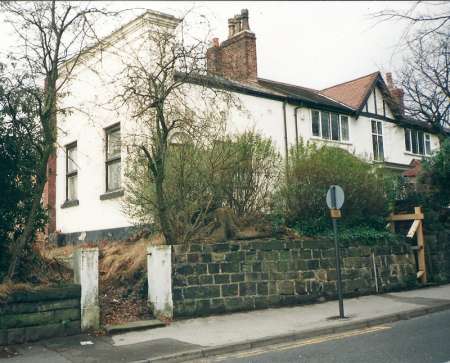(Old) Manchester Golf Club House
1824-1825 Golf Club House Singleton Road
Reference: James A Johnson: Notes and Jottings about the Early Days of the Old Manchester Golf Club
A special meeting of the Manchester Golf Club was held in July 1824, when It was resolved that it would add much to the comfort of the club, and probably increase the number of weekly attendants, if a room could be provided for their weekly meetings where they could dine and receive their friends in a more private manner than in a public inn. As no room sufficiently commodious could be found in the vicinity of Kersall Moor, a subscription was entered into for building and furnishing one for these purposes, The site fixed upon was contiguous to the cottage near Kersall Moor occupied by Mary Smith, the property of the Revd. John Clowes, whose consent was obtained with the assurance that the Club should never be disturbed during his life time and that no ground rent would be required. The cottage occupied by Mary Smith was adjacent to the farm leased to William Smith by the Revd. John Clowes. A map of the Kersal area dated 1832 shows Smith's Farm to be a short distance up the turnpike road now known as Singleton Road. The Club House is marked on the first OS map of 1848 as "Golf House."
No plan or drawing of the original club house is known to exist. However, the club's archives contain dozens of bills, invoices and receipts covering the early days on Kersal Moor, and theyinclude several for the materials supplied for the building and furnishing of the club house. There is an invoice from a William Heap, marble and stone mason, of Manchester, for a black marble chimney piece fitted with a Millington Stone back, £7. 10. 0d, and another from Hutchinson & Mallalieu for a Full Stove Grate, £4. 0. 0d., a green fender, 17/- ; a set of fire irons, 16/-; and a Japille coal box, 4/6d. There is a bill from Emanuel Mason, plumber, of 57 Miller-street, for three marble wash basins at 3/ -each. Simon Jones, slater, of 19 Timber-street, did some work on the roof of the 'Gough House' for 19/8d, which included “2 men, 12 days at 4/6d per day; and one shilling for laths and nails.” John Bolton, plasterer, sent in a bill for plastering the 'Goff house near Carsey Moor'. The new club house seems to have had a veranda, since there is a bill from a John Bell, of Collyhurst, for “priming and painting verandar at the golf house ..... 11/4d.” There is also an estimate from Thomas Findley, plasterer and decorator, for Abeautifying the Golf Room, situate Kersall Moor... the ceiling to be whitewashed, walls to be papered with oak paper thrown into panels with ornamental moulds to instructions given: the woodwork to be painted oak colour grained and varnished ..... £11. 0s. 4d".
A man named John Boden, builder and contractor, provided some of the materials for the building of the club house. Mr. Boden seems to have employed someone called Jimmy, who had a horse and cart, to transport his materials to Kersal Moor. On one of Mr Boden's bills, dated May 28th, 1825, is an item: “To Jimmy, with horse and cart, and Toll Bars ..... 7s. 0d”. The Toll Bar referred to on this bill would probably be the one at Singleton Brook, at the junction of Singleton Road and Bury Old Road, or possibly the one at the Half Way House. The Toll Bar at Kersal did not come into existence until about 1830. There call be little doubt that the gentlemen of Kersal Moor intended running their golf club in style. The club members provided themselves with silver knives and forks and spoons engraved with the club's initials, and their table linen was of the 'Best damask'. There are invoices for dinner plates, vegetable dishes, soup tureens, sauce tureens, and butter boats, and there is an invoice from a James Ward, cut glass manufacturer, of 59, King street, Manchester, for ”2 Quart Decanters, Richly Cut ........ £1 0s. 0d.
Later in the Victorian period the Club Room was incorporated into the adjoining house and stood until the building of Jacobite Close. Until its demolition it was considered by some to be the oldest surviving purpose-built golf club house in the world
